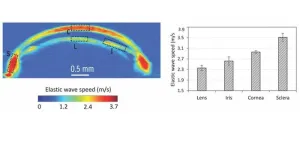(Press-News.org) A new study by researchers from the University of Bath (UK) and Universidad Nacional Autónoma de México (Mexico) shows that flowering plants escaped relatively unscathed from the mass extinction that killed the dinosaurs 66 million years ago. Whilst they suffered some species loss, the devastating event helped flowering plants become the dominant type of plant today.
There have been several mass extinctions in the Earth’s history, the most famous caused by an asteroid hit 66 million years ago, which has steered the course of life on Earth profoundly.
The Cretaceous-Paleogene (K-Pg) extinction event eradicated at least 75% of all species on Earth including the dinosaurs, but until now it’s been unclear what impact it had on flowering plants.
Plants do not have skeletons or exoskeletons like most animals, meaning fossils are relatively rare compared to animals, making it very difficult to understand the timeline of evolution from fossil evidence alone.
Dr Jamie Thompson of the Milner Centre for Evolution and Dr Santiago Ramírez-Barahona of Universidad Nacional Autónoma de México analysed evolutionary trees constructed from mutations in the DNA sequences of up to 73,000 living species of flowering plants (angiosperms).
Using complex statistical methods, they fitted “birth-death” models to estimate the rates of extinction throughout geological time.
Whilst the fossil record shows that many species did disappear, the lineages to which they belong, such as families and orders, survived enough to flourish and then dominate – out of around 400,000 plant species living today, approximately 300,000 of these are flowering plants.
Molecular clock evidence suggests that the vast majority of angiosperm families around today existed before the K-Pg event: species including the ancestors of orchids, magnolia and mint all shared Earth with the dinosaurs.
Dr Jamie Thompson said: “After most of Earth’s species became extinct at K-Pg, angiosperms took the advantage, similar to the way in which mammals took over after the dinosaurs, and now pretty much all life on Earth depends on flowering plants ecologically.”
So what made them tough enough to survive despite being immobile and relying on the sun for energy?
Dr Ramírez-Barahona said: “Flowering plants have a remarkable ability to adapt: they use a variety of seed-dispersal and pollination mechanisms, some have duplicated their entire genomes and others have evolved new ways to photosynthesise.
“This ‘flower power’ is what makes them nature’s true survivors.”
The study is published in Biology Letters and the project was supported by benefactors Roger and Sue Whorrod.
END
Nature’s great survivors: Flowering plants survived the mass extinction that killed the dinosaurs
New study tracks how “flower power” survived mass extinction 66 million years ago to become the dominant plant type.
2023-09-13
ELSE PRESS RELEASES FROM THIS DATE:
Death rates following first heart attack have gone down for those without diabetes or with type 2 diabetes, but not for type 1 diabetes
2023-09-13
*Note- this is an early release from the Annual Meeting of the European Association for the Study of Diabetes (EASD) meeting in Hamburg, October 2-6. Please credit the meeting if you use this story*
New research to be presented at this year’s Annual Meeting of the European Association for the Study of Diabetes (EASD) in Hamburg, Germany (2-6 October) shows that, following a heart attack, there have been falls in the death rates of both people without diabetes and those with type 2 diabetes, but not those with type 1 diabetes. The study is by Dr Linn ...
University of Alberta to offer pioneering AI education to all undergraduate students
2023-09-12
The University of Alberta (U of A), a globally recognized leader in Artificial Intelligence (AI) and Machine Learning, along with Amii (Alberta Machine Intelligence Institute), are breaking new ground with the launch of "Artificial Intelligence Everywhere," a new online introductory course accessible to all U of A undergraduates. The course is the cornerstone for an in-development AI certification, which will be one of the first in Canada.
The course equips students across all disciplines with essential AI literacy skills. With AI permeating sectors from health care to finance, this initiative bridges the AI skills ...
Making mammography inclusive for patients with disabilities
2023-09-12
Lene Andersen, MSW, has been living with rheumatoid arthritis and disability since childhood. Her personal experience with limited mobility and the challenges faced in accessing mammography screening in Toronto, Ontario, has fueled her determination to advocate for change. Her story is featured in an upcoming themed issue of the Journal of Medical Imaging and Radiation Sciences on the topic of specialized populations, published by Elsevier.
In this personal narrative, Lene, an advocate and accessibility consultant, teamed up with Natasha Batchelor, MHSc, MRT(R), a medical imaging technologist from the York region in Ontario with expertise in creating an accessible mammography ...
New imaging technique measures elasticity of multiple eye components simultaneously
2023-09-12
The eye is a highly complex organ, composed of intricate structures combining several types of specialized tissues. Under normal conditions, these structures work seamlessly together to provide clear images of the world around us as well as maintain intraocular pressure. However, when ocular diseases set in, the biomechanical properties of eye components change, disrupting their normal functioning. Most importantly, the alternations in biomechanical properties of the eye often lead to significant ocular diseases and vision loss. In order to study, diagnose, and monitor ocular diseases, it is, therefore, ...
Novel emerging nano-assisted anti-cancer strategies based on the STING pathway
2023-09-12
https://www.scienceopen.com/hosted-document?doi=10.15212/AMM-2023-0023
Announcing a new publication for Acta Materia Medica journal. Activation of simulator of interferon genes (STING), which induces the production of proinflammatory factors and immune effector cell activation, is considered a promising strategy for enhanced anti-cancer intervention. However, several obstacles prevent STING signaling in solid tumors, such as delivered molecules’ rapid degradation, restriction to tumor sites, insufficient intracellular concentrations, and low responsivity. ...
'Team Waponi' advances to finals of $10M XPRIZE Rainforest Competition with 'Limelight', earns $300K semi-finalist prize
2023-09-12
NJIT biology professor Eric Fortune and a team of scientists, known as “Team Waponi”, have reached the final stage of the five-year, $10M XPRIZE Rainforest Competition.
In June, Fortune and 13 other team members traveled to the rainforests of Singapore to compete in the semi-finals of the global competition, which challenged teams to develop and demonstrate new technologies for mapping the vast biodiversity of the world's tropical forests.
The team’s biodiversity sampling device, called “Limelight”, has captured exactly that so far — securing them a spot among six finalists to advance from the field of 13 teams, while earning ...
Charging ahead: New electrolyte goes extra mile for faster EV charging
2023-09-12
Oak Ridge National Laboratory researchers are taking fast charging for electric vehicles, or EVs, to new extremes.
A team of battery scientists recently developed a lithium-ion battery material that not only recharges 80% of its capacity in 10 minutes but keeps that ability for 1,500 charging cycles.
When a battery operates or recharges, ions move between electrodes through a medium called the electrolyte. ORNL’s Zhijia Du led a team who developed new formulations of lithium salts with carbonate solvents to form an electrolyte that maintains better ion flow over time and performs well when high current heats up the battery ...
Smartphone technology expected to advance assessment of neurological soft signs in schizophrenia
2023-09-12
September 12, 2023 — Since the 1980s, we have known that neurological soft signs (NSS) can distinguish people with schizophrenia from psychiatrically healthy individuals. NSS are subtle neurological impairments that principally manifest as decreased sensory integration (trouble receiving and responding to information transmitted to the brain through the senses) and difficulties with balance, rapid successive movements, and right–left orientation.
NSS doesn't always cause impairment of daily living, but identifying them could improve the diagnosis and treatment of schizophrenia and enhance understanding of the ...
Kessler Foundation receives $725,000 grant for study to accelerate functional recovery in multiple sclerosis
2023-09-12
East Hanover, NJ – September 12, 2023 – Carly Wender, PhD, associate research scientist in the Center for Neuropsychology and Neuroscience Research at Kessler Foundation received a three-year $725,499 grant from the National Multiple Sclerosis Society for her study, “A Novel Combinatory Approach to Maximize Functional Recovery of Learning and Memory in Multiple Sclerosis.”
Cognitive impairment is a common symptom in individuals with multiple sclerosis (MS) that can be particularly ...
Older adults with digestive diseases experience higher rates of loneliness, depression
2023-09-12
While life expectancy rates for older Americans are rising, nearly 40% of adults report living with a digestive disease of some kind.
“Many people don’t realize that these conditions are very common in ambulatory care,” said Michigan Medicine gastroenterologist Shirley Ann Cohen-Mekelburg, M.D., who specializes in conditions like inflammatory bowel disease, Crohn’s disease and ulcerative colitis.
“Ultimately, this creates an excess in health care spending in the United States. Not only are these conditions debilitating for the millions of people living with them, ...
LAST 30 PRESS RELEASES:
New expert guidance urges caution before surgery for patients with treatment-resistant constipation
Solar hydrogen can now be produced efficiently without the scarce metal platinum
Sleeping in on weekends may help boost teens’ mental health
Study: Teens use cellphones for an hour a day at school
After more than two years of war, Palestinian children are hungry, denied education and “like the living dead”
The untold story of life with Prader-Willi syndrome - according to the siblings who live it
How the parasite that ‘gave up sex’ found more hosts – and why its victory won’t last
When is it time to jump? The boiling frog problem of AI use in physics education
Twitter data reveals partisan divide in understanding why pollen season's getting worse
AI is quick but risky for updating old software
Revolutionizing biosecurity: new multi-omics framework to transform invasive species management
From ancient herb to modern medicine: new review unveils the multi-targeted healing potential of Borago officinalis
Building a global scientific community: Biological Diversity Journal announces dual recruitment of Editorial Board and Youth Editorial Board members
Microbes that break down antibiotics help protect ecosystems under drug pollution
Smart biochar that remembers pollutants offers a new way to clean water and recycle biomass
Rice genes matter more than domestication in shaping plant microbiomes
Ticking time bomb: Some farmers report as many as 70 tick encounters over a 6-month period
Turning garden and crop waste into plastics
Scientists discover ‘platypus galaxies’ in the early universe
Seeing thyroid cancer in a new light: when AI meets label-free imaging in the operating room
Neutrophil-to-lymphocyte ratio may aid risk stratification in depressive disorder
2026 Seismological Society of America Annual Meeting
AI-powered ECG analysis offers promising path for early detection of chronic obstructive pulmonary disease, says Mount Sinai researchers
GIMM uncovers flaws in lab-grown heart cells and paves the way for improved treatments
Cracking the evolutionary code of sleep
Medications could help the aging brain cope with surgery, memory impairment
Back pain linked to worse sleep years later in men over 65, according to study
CDC urges ‘shared decision-making’ on some childhood vaccines; many unclear about what that means
New research finds that an ‘equal treatment’ approach to economic opportunity advertising can backfire
Researchers create shape-shifting, self-navigating microparticles
[Press-News.org] Nature’s great survivors: Flowering plants survived the mass extinction that killed the dinosaursNew study tracks how “flower power” survived mass extinction 66 million years ago to become the dominant plant type.




